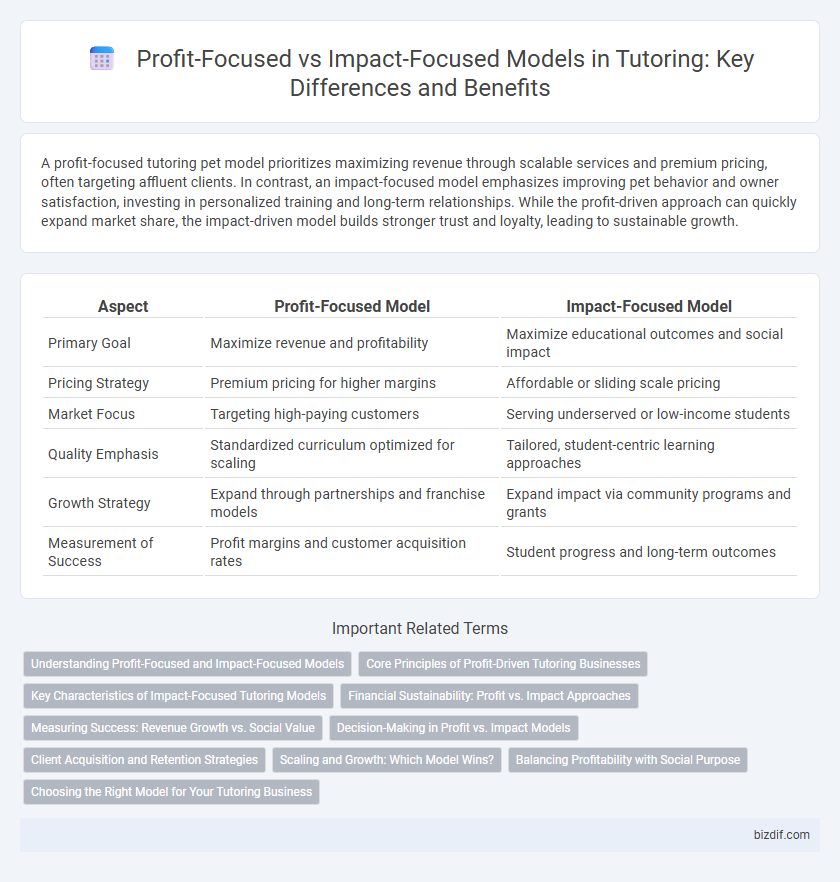A profit-focused tutoring pet model prioritizes maximizing revenue through scalable services and premium pricing, often targeting affluent clients. In contrast, an impact-focused model emphasizes improving pet behavior and owner satisfaction, investing in personalized training and long-term relationships. While the profit-driven approach can quickly expand market share, the impact-driven model builds stronger trust and loyalty, leading to sustainable growth.
Table of Comparison
| Aspect | Profit-Focused Model | Impact-Focused Model |
|---|---|---|
| Primary Goal | Maximize revenue and profitability | Maximize educational outcomes and social impact |
| Pricing Strategy | Premium pricing for higher margins | Affordable or sliding scale pricing |
| Market Focus | Targeting high-paying customers | Serving underserved or low-income students |
| Quality Emphasis | Standardized curriculum optimized for scaling | Tailored, student-centric learning approaches |
| Growth Strategy | Expand through partnerships and franchise models | Expand impact via community programs and grants |
| Measurement of Success | Profit margins and customer acquisition rates | Student progress and long-term outcomes |
Understanding Profit-Focused and Impact-Focused Models
Profit-focused tutoring models prioritize maximizing revenue through scalable services and high enrollment, often leveraging technology to reduce operational costs. Impact-focused models emphasize personalized learning outcomes and student growth, investing in customized curricula and intensive support to enhance educational achievement. Understanding these models helps stakeholders balance financial sustainability with meaningful learning impact in tutoring programs.
Core Principles of Profit-Driven Tutoring Businesses
Profit-driven tutoring businesses prioritize scalable service delivery, leveraging technology and standardized curricula to maximize revenue and reduce operational costs. Their core principles emphasize measurable outcomes, customer retention strategies, and data-driven marketing to drive profitability. This model often balances high-quality instruction with efficiency, ensuring consistent enrollment growth and financial sustainability.
Key Characteristics of Impact-Focused Tutoring Models
Impact-focused tutoring models emphasize personalized learning plans tailored to individual student needs, fostering deeper comprehension and long-term academic growth. These models prioritize measurable student outcomes, such as improved test scores and increased engagement, over immediate financial gains. Collaboration between tutors, educators, and families is a key characteristic, ensuring a holistic support system that addresses cognitive and emotional development.
Financial Sustainability: Profit vs. Impact Approaches
Profit-focused tutoring models prioritize maximizing revenue through scalable services and premium pricing, ensuring financial sustainability by attracting a broad customer base and optimizing operational efficiency. Impact-focused tutoring models emphasize educational outcomes and long-term student success, often relying on grants, subsidies, or philanthropic funding to maintain financial sustainability while delivering measurable social benefits. Balancing financial metrics with educational impact is crucial for tutoring services aiming to achieve both profitability and meaningful student progress.
Measuring Success: Revenue Growth vs. Social Value
Measuring success in tutoring models varies between profit-focused and impact-focused approaches, with the former prioritizing revenue growth metrics such as client acquisition rates and profit margins. In contrast, impact-focused models emphasize social value indicators like student progress, literacy improvement rates, and long-term educational outcomes. Balancing both financial performance and measurable social impact fosters sustainable growth and meaningful contributions to learning communities.
Decision-Making in Profit vs. Impact Models
Profit-focused tutoring models prioritize maximizing revenue through enrollment numbers, pricing strategies, and cost management, often driving decisions based on short-term financial gains. Impact-focused tutoring models emphasize student outcomes, learning improvements, and long-term educational benefits, guiding decisions by measuring effectiveness and fostering personalized support. Decision-making in profit models centers on scalability and market demand, while impact models rely on pedagogical data and continuous assessment to enhance learning experiences.
Client Acquisition and Retention Strategies
Profit-focused tutoring models prioritize aggressive client acquisition through targeted marketing campaigns and competitive pricing, aiming to maximize revenue quickly. In contrast, impact-focused tutoring emphasizes long-term client retention by delivering personalized learning experiences and measurable academic improvements that foster trust and loyalty. Combining data-driven outreach with quality educational outcomes enhances both acquisition rates and sustainable retention in tutoring services.
Scaling and Growth: Which Model Wins?
A profit-focused tutoring model prioritizes rapid scaling through aggressive marketing and cost-efficiency, enabling swift expansion and increased revenue. In contrast, an impact-focused model concentrates on personalized learning outcomes and student success, fostering sustainable growth through strong reputation and client retention. While the profit-driven approach accelerates numerical growth, the impact-centered model ensures long-term scalability rooted in quality and meaningful educational results.
Balancing Profitability with Social Purpose
A tutoring business balancing profitability with social purpose integrates a profit-focused model that ensures sustainable revenue streams while adopting an impact-focused model to deliver measurable educational outcomes and community benefits. This hybrid approach leverages data-driven strategies to optimize operational efficiency and scale access to high-quality tutoring for underserved students, thereby aligning financial goals with social impact. By prioritizing both profit margins and student success metrics, tutoring organizations can achieve long-term growth and meaningful educational advancements.
Choosing the Right Model for Your Tutoring Business
Profit-focused tutoring models prioritize maximizing revenue through scalable pricing and student volume while leveraging technology for efficiency. Impact-focused models emphasize personalized learning outcomes, fostering deep understanding and long-term academic growth, often requiring smaller class sizes or individualized sessions. Selecting the right model for your tutoring business depends on balancing financial goals with educational effectiveness to sustainably meet student needs.
Profit-focused model vs impact-focused model Infographic

 bizdif.com
bizdif.com